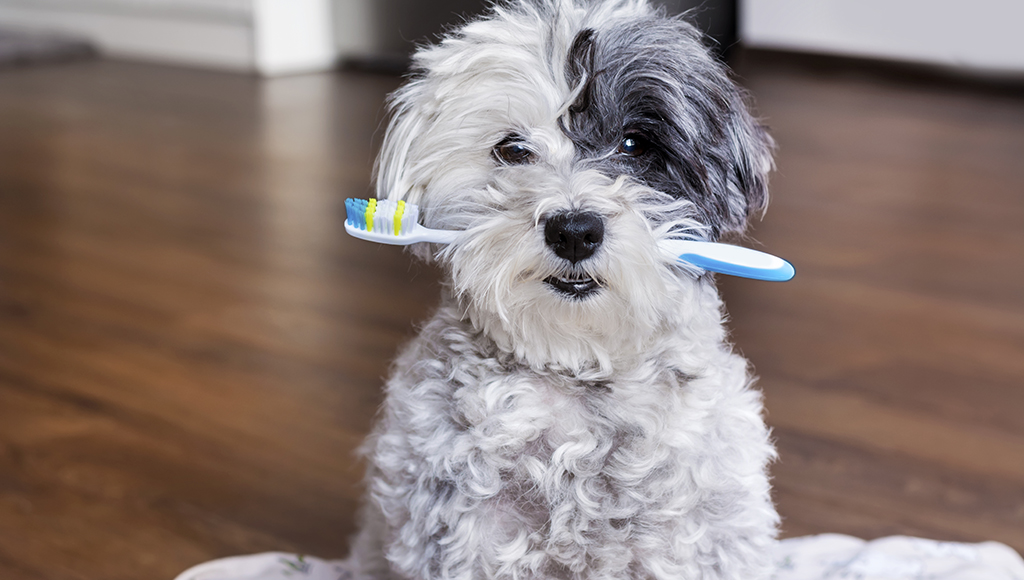Brush Up On The Facts About Good Pet Dental Hygiene
February is Pet Dental Month.

It is estimated that 80 percent of people brush their teeth every day, but far fewer pet owners do the same for their pets. Pet Dental Health Month, celebrated every February, is to intended to educate pet owners that proper dental hygiene is equally as important for their pets.
Most people have no idea that dental health is so important or even necessary for their pets. Unfortunately periodontal disease is reported by many veterinarians as the most commonly diagnosed problem in cats and dogs. This disease can lead to painful infections of the mouth, and in severe cases these infections can spread and sometimes even become life-threatening conditions. Periodontal disease, an infection of the gums, is incredibly common in pets. It's estimated that by the age of two, 80 percent of dogs and 70 percent of cats have some form of periodontal disease. Periodontal infections have been linked to diabetes, heart attacks, strokes, kidney disease and other life threatening disorders. The best way to prevent periodontal disease is by regularly brushing your pet's teeth and by regularly visiting your veterinarian.
During Pet Dental Health Month, the AVMA (American Veterinary Medical Association) encourages all dog and cat owners to regularly brush their pet’s teeth and regularly see their veterinarian for checkups annually. An informative video providing step-by-step instructions on how to brush your pet's teeth can be viewed online at the AVMA web site.
The most common disease in dogs is periodontal disease. It affects 85% of dogs over 5 years old and occurs in cats as well. Plaque and tartar accumulating on the tooth surfaces are full of bacteria that may cause a loss of attachment of the tooth to the supporting bone, gum tissue and periodontal ligaments. This attachment loss creates an increased space between the teeth and the gums that can harbor a more harmful bacteria. This space is called a periodontal pocket. It is the harmful bacteria or infection, living in this space that causes the halitosis or bad breath that we associate with periodontal disease.
Untreated periodontal disease causes progressive attachment loss and ultimately leads to chronic infections under the gum line. Dogs with untreated periodontal disease are prone to having their teeth fall out, spontaneous jaw fractures, and they are more prone to diseases of other organs including the heart, lungs, kidneys and liver. The underlying periodontal disease can also be painful, but we tend not to notice our pet’s pain because it creeps up slowly over several years. As pet owners we tend to assume our pet slowing down is just part of the normal aging process. Many times, it’s the oral discomfort from dental disease causing the changes in our pets. If your pet has halitosis, or bad breath, periodontal disease should be considered. Red gums, bleeding gums, root exposure, gum recession and loose teeth may also be signs of advanced periodontal disease.
Diagnosis and treatment of periodontal disease requires general anesthesia. All patients should be prescreened to determine their ability to safely handle anesthesia. This includes a thorough examination, blood tests and sometimes other tests. Diagnosis is made by probing the periodontal tissues surrounding each tooth to look for evidence of bone loss and gum loss. Intra-oral radiographs or x-rays are also taken to evaluate the amount of bone loss present. Treatment for periodontal disease in our pets depends on how advanced the disease is. Treatments include routine dental cleanings for mild cases, medical or surgical therapies for moderate cases and extraction therapy for advanced cases. Many pet owners report that their pet seems happier or younger after successful treatment of periodontal disease.
Periodontal disease is often preventable through proper oral hygiene. This involves thorough home health care including brushing the teeth daily. Dental diets are also available for keeping the teeth cleaner. Dental sealants may be used to prevent plaque and tartar accumulation. There is a new periodontal vaccine that may be helpful in reducing bone loss associated with periodontal disease. Also, regular cleanings under general anesthesia are recommended to keep the teeth clean above and below the gum line.
If you notice halitosis, red gums, bleeding gums, loose teeth, discolored teeth or oral discomfort in your pet, you should be considering an oral evaluation for periodontal disease or other dental problems seen in dogs and cats. Our pets give us so much love. The least we can do for our pets is help to maintain them with healthy, pain free, infection free mouths.
Ready to start saving money on pet wellness care?
Then take a look at Mint Wellness, the pet wellness plan that provides fast reimbursement on routine pet care. Save on vaccinations, wellness exams, preventatives, dental, and more!
Learn More


